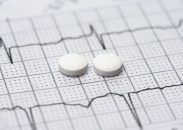Timely percutaneous intervention of STEMI patients effectively reduces MI size and mortality, which currently makes it the first line of treatment. A fundamental aspect is activation and platelet aggregation, which is why, in addition to creating networks to optimize STEMI treatment, prehospital drug treatments have been implemented. The COMPARECrush looked at whether early and powerful…
Ticagrelor or Prasugrel Post-PCI in Daily Practice Patients
The ISAR-REACT 5 showed a significant reduction in the composite outcome of death, acute myocardial infarction (AMI), or stroke when using prasugrel vs. ticagrelor in patients with acute coronary syndrome (ACS), mainly at the expense of an AMI reduction. While this study changed clinical practice, it has stirred some criticism regarding certain methodological aspects, such…
ESC 2021 | ISAR-REACT 5: Prasugrel Superior to Ticagrelor in ACS across Kidney Function Spectrum
When we have to choose between two potent P2Y12 receptor inhibitors for a patient undergoing ACS with a planned invasive strategy, kidney function should not interfere in this decision. The main findings of this study were that prasugrel has lower risk of all cause death, MI or stroke, and also had a similar risk of…
Dual Antiaggregation De-Escalation: A New Paradigm?
De-escalating dual antiaggregation could be the most effective strategy after acute coronary syndrome seeing as it prevents bleeding and cut down costs with no increase of ischemic events. Balancing the effects of dual antiaggregation therapy (DAPT) in the era of potent P2Y12 inhibitors has become the cornerstone of acute coronary syndrome (ACS) management. This meta-analysis…
Ticagrelor or Prasugrel for Acute Patients Who Undergo Angioplasty
We are still asking the same question: ticagrelor or prasugrel? With narrow margins between these drugs in terms of efficacy and bleeding, it is difficult to decide which to prescribe. While it has certain methodological limitations, this research published in JAMA seems to clarify the picture at least for patients with acute coronary syndromes who…
The Most Read Scientific Articles in Interventional Cardiology
01- How To De-Escalate Prasugrel After Acute Coronary Syndrome? Patients who undergo coronary angioplasty after acute coronary syndrome could de-escalate dual antiplatelet therapy with prasugrel to maintain the protection against ischemic events while lowering their hemorrhagic risk. Read more HERE 02- Not All Coronary Spasms Are the Same: Benefits of Acetylcholine Patients with documented spasm…
Ticagrelor or Prasugrel in ST Elevation MI
In patients undergoing ST elevation acute myocardial infarction (STEMI) receiving primary PCI, no significative differences between prasugrel and ticagrelor were found. However, the latter was associated to a significantly higher number of repeat MI when considered separately. Few studies have compared the efficacy and safety of the two most potent oral P2Y12 receptor inhibitors in…
Angioplasty in Aspirin-Free Stable Patients with Prasugrel: Innovation Continues
Potent P2Y12 receptor inhibitors, such as prasugrel and ticagrelor, have been tested mainly in a setting of acute coronary syndromes. There is little evidence on stable patients, particularly for prasugrel. Designing a study with that purpose seemed challenging enough, but adding aspirin discontinuation in patients without a particularly high bleeding risk took this research to…
TCT 2020 | Crushed Prasugrel Administration prior PCI
Prehospital administration of crushed tablets of prasugrel loading dose in the ambulance while patient is on his way to primary PCI does not improve reperfusion markers compared against uncrushed tablet administration according to the COMPARE CRUSH, presented at the virtual TCT 2020 and simultaneously published in Circulation. There were no differences in TIMI flow of…
How To De-Escalate Prasugrel After Acute Coronary Syndrome?
Patients who undergo coronary angioplasty after acute coronary syndrome could de-escalate dual antiplatelet therapy with prasugrel to maintain the protection against ischemic events while lowering their hemorrhagic risk. The HOST-REDUCE-POLYTECH-ACS study (recently published in The Lancet) included 2338 patients who underwent coronary angioplasty in a setting of acute coronary syndrome. Patients were randomized to a year-long…









